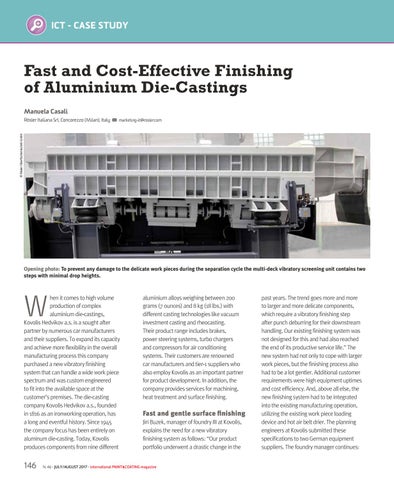ICT - CASE STUDY
Fast and Cost-Effective Finishing of Aluminium Die-Castings Manuela Casali marketing-it@rosler.com
© Rösler Oberflächentechnik GmbH
Rösler Italiana Srl, Concorezzo (Milan), Italy
Opening photo: To prevent any damage to the delicate work pieces during the separation cycle the multi-deck vibratory screening unit contains two steps with minimal drop heights.
W
hen it comes to high volume production of complex aluminium die-castings, Kovolis Hedvikov a.s. is a sought after partner by numerous car manufacturers and their suppliers. To expand its capacity and achieve more flexibility in the overall manufacturing process this company purchased a new vibratory finishing system that can handle a wide work piece spectrum and was custom engineered to fit into the available space at the customer’s premises. The die-casting company Kovolis Hedvikov a.s., founded in 1816 as an ironworking operation, has a long and eventful history. Since 1945 the company focus has been entirely on aluminum die-casting. Today, Kovolis produces components from nine different
146
aluminium alloys weighing between 200 grams (7 ounces) and 8 kg (18 lbs.) with different casting technologies like vacuum investment casting and rheocasting. Their product range includes brakes, power steering systems, turbo chargers and compressors for air conditioning systems. Their customers are renowned car manufacturers and tier-1 suppliers who also employ Kovolis as an important partner for product development. In addition, the company provides services for machining, heat treatment and surface finishing.
Fast and gentle surface finishing Jiri Buzek, manager of foundry III at Kovolis, explains the need for a new vibratory finishing system as follows: “Our product portfolio underwent a drastic change in the
N. 46 - JULY/AUGUST 2017 - international PAINT&COATING magazine
past years. The trend goes more and more to larger and more delicate components, which require a vibratory finishing step after punch deburring for their downstream handling. Our existing finishing system was not designed for this and had also reached the end of its productive service life.” The new system had not only to cope with larger work pieces, but the finishing process also had to be a lot gentler. Additional customer requirements were high equipment uptimes and cost efficiency. And, above all else, the new finishing system had to be integrated into the existing manufacturing operation, utilizing the existing work piece loading device and hot air belt drier. The planning engineers at Kovolis submitted these specifications to two German equipment suppliers. The foundry manager continues:
